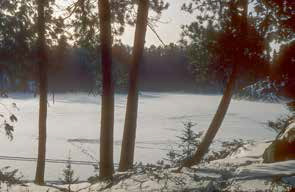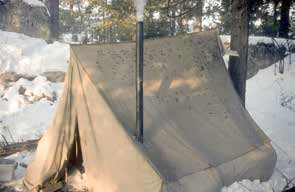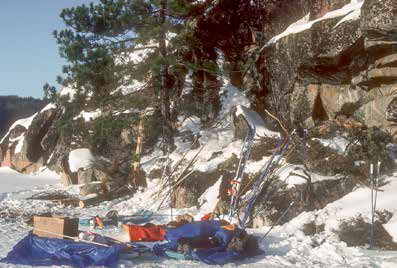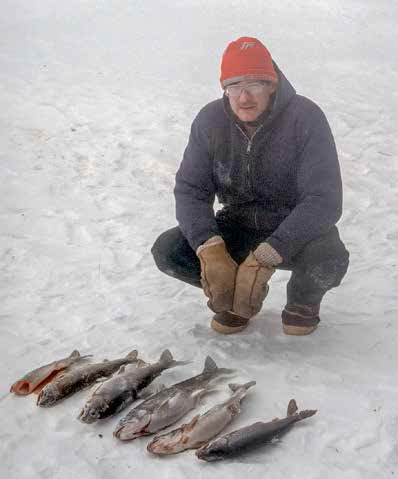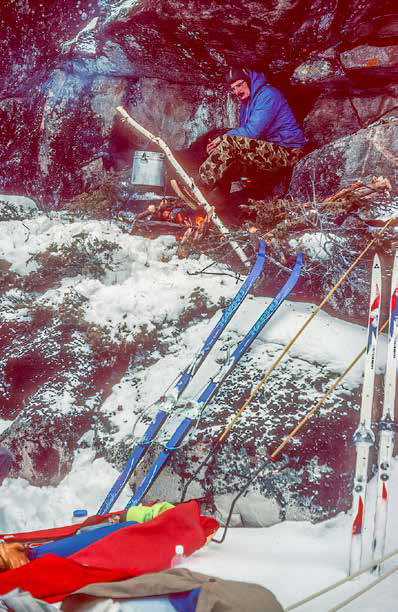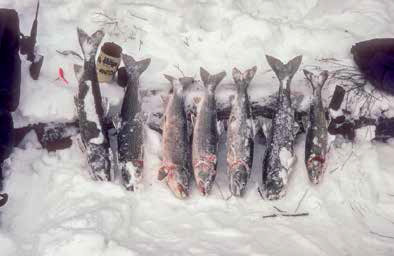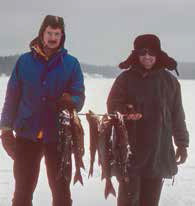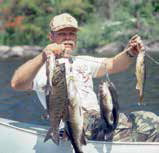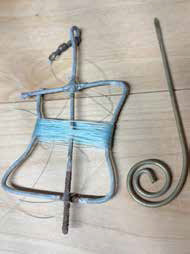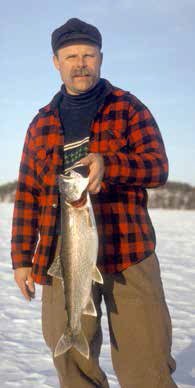Chapter 7 – Burke Lake
I was at a Super Bowl get together this year, and former student Andy Luthens was there.
He had a DVD that he lent me that contained transcribed 8mm footage of his dad and friends on several winter camping trips into Burke Lake fishing for lake trout. The trips took place from about 1980 until ‘85. The expeditions were great, the friendships obviously jovial and did they ever catch some pigs!
It brought back many memories of my own journeys into that country at about the same time.
My first trip to Burke was in 1981 and the scenery, abundant fish and yes, even some of the mustaches and beards reminded me so much of my winter trips across into the Quetico. Times were simpler then, and a Canadien fishing license – along with a sense of adventure – were about all you needed!
Gear was more primitive than it is today. The early trips were made carrying #4 Duluth packs and eventually turned into pulling sleds. The nylon “cold” tents necessitated lofty down sleeping bags and plenty of clothing to stay warm. Canvas “hot” tents became a luxury on later trips that allowed cribbage being played long into the night in shirt sleeves before turning in. Instead of tip-ups, fancy fishing rigs and sonar to locate fish, we relied on stringing ciscos with “threaders” and wire hanging rigs tied with orange flagging tape to indicate when a fish had taken our offered fare. Locating where the fish were meant relying on landmarks from successful past trips and drilling hole after hole while scouting new territory.
All my winter trips included my friend Tom and/or former schoolmate Ross Petersen.
Various others would round out the expeditionary force. When we went north of the border, we would primarily fish Burke, but at times would make a day trip into Sunday Lake. Fish caught in Burke were beautiful examples of traditional lake trout. As I remember, fish taken in Sunday Lake tended to be less colorful and almost black. The difference didn’t extend to the taste, however. They were just as good as any other taken from any lake they can be found! Our early trips found us skiing from Moose Lake landing, down New Found and Sucker to Prairie Portage, through Inlet Bay and down the east side of Bayley Bay to the Burke portage. Later we’d go through Found to Manoman, into Rice Bay and across Bayley Bay to reach the same destination.
My first trip is the one most burned into my memory. It was over New Year’s Day of 1981 and lasted for four days. The forecast was for cold weather, but we were used to it and would be well prepared – or so we thought – to survive it. The temp read –20F as we left the landing the first morning. My pack was a #4 Duluth canvas pack stuffed full.
To keep my shoulder blades from permanently kissing in the middle of my back, I tied a rope across my chest holding the leather shoulder straps together. There was no waist belt or tumpline, so the weight pulled back on my shoulders and pushed into my lower back. My skis were Karhu backcountries with cable bindings and for ski boots I had an old pair of leather high top mine boots with steel toes.
Our party was made up of my buddy Tom, his friend Kurt Zimpel and a friend of Kurt’s. We all had spent time winter camping, so we hoped experience would see us through.
There was a considerable amount of snow on the ice. Part of the route had snowmobile tracks on it, as the machines were still allowed to Knife Lake. Even with all the cold, the snow insulated well enough that there were several huge slush pockets down the lakes. Slush is a real problem when skiing or snowshoeing. The water instantly freezes onto the bottom or your skis along with thirty pounds of slushy snow.
When we hit a pocket, we would jump out of our skis and run through the water until we hit solid snow again. From there we would take a scraper out of our pocket and scrape the skis down.
Any slush that froze on the skis would act like sandpaper against the snow and wouldn’t allow any glide. Seemed like we hit a pocket every quarter mile or so.
We struggled on until we got to Prairie Portage. Because of the current, it’s a dangerous spot.
We hugged the south shoreline tightly until we made our way to the portage itself. Coming out onto Inlet Bay, conditions seemed to improve a bit. That was until we came around the corner facing west across miles of Basswood stretching out ahead of us. The wind had plenty of chance of picking up a head of steam and the windchill took my breath away. I’d never seen anything like that before. We tried to hurry to get behind Green Island and at least a bit of cover. It wasn’t quite as bad from there as we made our way to the Burke portage.
The trail into Burke was good, and there was enough tree cover on the south end of the lake to afford us some respite until we crossed to where we were going to camp. It was getting late, but not too late to put some lines down before we set up camp. Tom brought his Timberline four-man tent. Normally, he and I would bring that for the two of us and have room for some gear in there.
By the time we put our sleeping pads on the floor with down bags on top, there was barely room for the four of us to lay side by side. Cozy, but in the long run it would probably help keep us a bit warmer.
We gathered some wood, made a fire and cooked some hot chocolate and supper. By then, it was starting to get dark and time to pull the lines. I don’t recall that we caught any fish that afternoon, but tomorrow would be a different day.
In the morning, we woke to slowly gathering light and long strings of frost hanging from the ceiling of the tent. It was cold, but the thermometer I brought along only indicated that it was seventeen below. It felt colder than that, but you can’t argue with science.
Coffee and oatmeal for breakfast was soon followed by setting up lines for the day. We had brought one ice scoop along. It was made of plastic and the water froze the holes on it with its first dip. Kurt tried to knock the ice off against the side of the hole, but the plastic snapped, and the scoop skittered down the open water to the bottom of Burke Lake. For the rest of the trip, we had to free the holes with our bare hands. Doing what we had to, we soon had eight rigs set up and it wasn’t long before the fish became active. We chased flags all day and caught plenty of the chunky lakers. We had three of the smaller ones for a big lunch and put some of the larger ones off to the side to bring home. The day ended with a light supper and crawling into our warm sleeping bags by 6:00. The temp still read –17, so we felt lucky that the day had treated us well.
Day three broke and it was almost an exact repeat of the day before. Lots of fish, plenty to eat and surprisingly the temperature remained steady. The two anomalies were that Tom accidentally kicked Kurt’s favorite polar bear coffee cup down one of the ice holes, and a pack of four wolves crossed the bay in front of us.
They loped one behind the other in a straight line, and number three was the first black wolf I’d ever seen. What a thrill!
The morning of the last day was spent in preparation for the trip out. Breaking down the tent – even with a good fire going – takes much longer in the winter.
By mid-morning Kurt’s friend was ready to take off and started across the bay back towards the portage. I was about half an hour behind him. We were still one fish short of our limit so Tom and Zimpel decided to stay a bit longer to see if they could catch one last one. Surprisingly, my thermometer seemed to be stuck at seventeen below.
The journey back started well.
There was still a brisk wind coming across Bayley Bay, but it was now at my back. Through Inlet Bay and across Prairie Portage went as planned. On the Sucker Lake side, I again attempted to bypass the thin ice by diving well to the south. All seemed well until almost across when the ice went out from under me. My heart jumped to my throat as my skis quickly went down through the water. At about knee depth, they stopped. There was a double layer of ice, filled with water in-between. I had dropped far enough that the bottom of my pack was resting on the top of the snow. I wiggled from the shoulder straps and had to thrust my arms into the water to unhook my skis and bring them above the surface.
Knowing I was now in trouble, and didn’t dare spend extra time standing around, I went from kneeling to standing and ran with my skis and trailing my pack to the shoreline. Putting myself back together, I hurried down Sucker Lake hoping to warm up enough to keep from freezing. I was almost to the corner going to the south when I hit the first slush pocket. The procedure that was necessary on the way in had to be repeated numerous times on the way out. Fortunately, by keeping moving as much as I could, I kept the cold at bay. Tom and Zimpel caught up to me just as I hit the north end of Moose Lake. With the end almost in sight, I knew we all were going to make it out fine.
Finally at the parking lot, we loaded everything into our trucks. A last check of the thermometer still said seventeen below. After I got home, I discovered that it was accurate down to –17, but not any colder than that. The temperature hadn’t gotten ABOVE –17 that whole trip! The last morning out, the temp in Ely was –42F.
The rest of our trips to Burke Lake were all a piece of cake compared to this one. Oh, we had some tough times on some other winter trips, but going into the Quetico in the following years was pleasant and uncomplicated. Our learning curve about cold weather camping continued forward!
